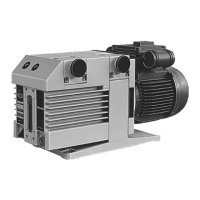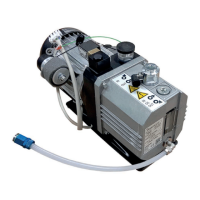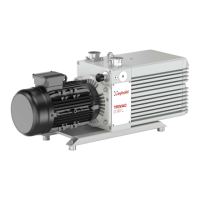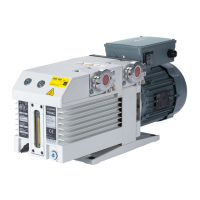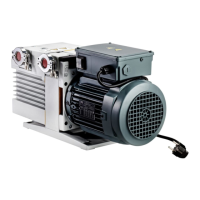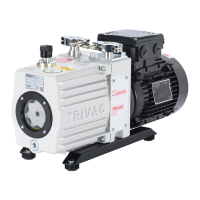t
I
4-3-3
6.
If the used pump fluid is very dirty, flush out the pump as follows:
a.
If not already done,
turn
off
the
pump and refer to Steps 1 through 5 to drain the used
pump fluid.
b.
CAUTION: WHEN FLUSHING OUT THE PUMP, FILL IT
TO
CAPACITY WITH PUMP
FLUID. SEE TABLE
4-1
FOR
THE FLUID CAPACITY OF YOUR PUMP MODEL.
Disconnect your vacuum line from the intake tube
(1),
turn the pump on, and
slowly
pour
clean pump fluid into the intake tube
(1)
while the pump
is
running.
c.
Allow the pump
to
run for at least 1 0 minutes, then turn it off.
d.Repeat
Steps
1,
3,
4,
and
5
to
drain the fluid from the pump.
e.
If the pump fluid used for flushing
is
dirty, repeat Steps 6b through
6e.
f.
Reconnect the vacuum line to the intake tube
(1).
7.
SEE THE SECTION 4-3-2 WARNING-Unscrew and remove the plug screw (8) from one
of
the
oil
fill ports (See Figure 1-1).
8.
NOTE: The fluid capacity of each dual stage TRIVAC pump model is listed
in
Table
4-1.
The cor-
rect pump fluid
is
listed in Section
5-A-1.
Pour the pump fluid
into
the oil fill port.
9.
Using an 8-mm allen wrench, reinstall the plug screw (8) with flat gasket (9) into the oil fill
port.
10.
If the negative pressure exhaust system
was
disconnected
in
Step
2,
reconnect it.
Checking the Pump
Fluid
for
Contamination
Occasionally check the pump fluid for contamination
by
looking through the oil level glass
(15)
on
the side of the
pump.
If the fluid
in
the oil-level glass
(15)
has
an
unusual
color,
is
very dark, or appears dirty or turbid, refer to
Section 4-3-2 to change the fluid. For anti-corrosive fluid, flakes
in
the fluid indicate that its corrosive resistance
is
spent and thus the fluid should
be
changed. The oil-sight tube
(72)
on the end of the
oil
casing does not give
an
accurate indication of the condition of the pump fluid
(see
Figure 5-1).
NOTE: See Section 4-2 for identifying and eliminating condensate from the pump fluid.
NOTE: See Symptom 2 of the Troubleshooting chart (Table
6-1)
for other methods of eliminating contamination
from the pump fluid.
NOTE:The frequency
of
pump fluid
change
can
vary from
several
months
to
every day depending
on
the
opera-
ting conditions
of
the pump. The frequency must
be
adjusted
to
the operating conditions.
If
the pump fluid
becomes
contaminated quickly,
use
an
OF-3000 or OF-1000 Oil Filtering System
to
protect the pump
and
to
ex-
tend the period between pump
fluid
changes.
4-3-4
long
Term Storage
(2
weeks
or
longer)
Use the Section 4-3-2 instructions to flush out the pump
and
change the pump fluid before
and
after the pump
is
stored for a lengthy period. After changing the fluid, run the pump for about
20
minutes with the intake sealed
off
and
the gas ballast valve open (see Section
2-3)
to ensure that all the internal parts are coated with clean pump
fluid.
Cover the intake
and
exhaust
of
the pump to prevent dirt, dust,
and
condensation from entering during storage.
4-3-5 Checking the
Dirt
Trap
Occasionally check the wire mesh
dirt
trap
(2)
that rests on the pump intake tube (1). A buildup of
contaminants on the
dirt
trap reduces the pumping speed.
4-3-6
Avoiding
Oil
Leaks
During
Shipping
and
Storage
Tightly sealing the pump's inlet
and
exhaust ports for shipping or storage can cause
oil
leaks. To avoid
oil
leaks during shipping
and
storage, use a flexible membrane or a rigid cover with a
pin
hole
on
the
pump's
inlet
and
exhaust ports. The flexible membrane
or
pin
hole accommodate the pressure differences that
occur during air shipments and during temperature changes.
As
further precautions against
oil
leaks during shipping,
we
insert a wedge up under the coupling housing
to hold the anti-suckback lever
and
seal
in
the closed position.
We
also drain the oil from the smaller pumps
in
case they are turned upside down.
TRIVAC "A" Manual, Edition L
13
-
